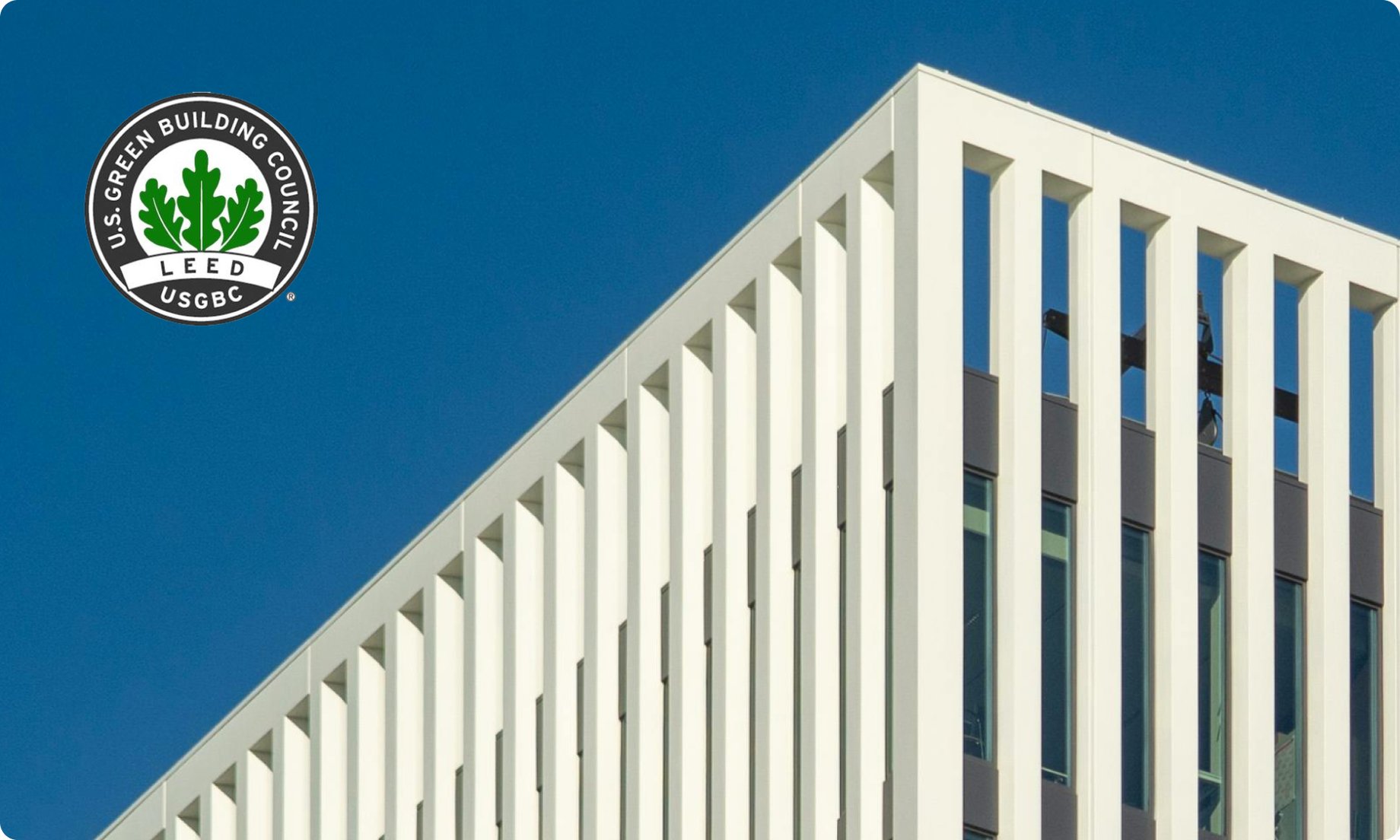The U.S. Green Building Council (USGBC) has officially released LEED v5, the most significant update to the global green building standard in over a decade. This new version reflects the built environment’s evolving role in addressing climate change, requiring deeper reductions in whole-life carbon emissions, integrating life-cycle assessment into core certification pathways, and emphasizing long-term environmental performance.

LEED v5 redefines sustainable building performance through three core impact areas: decarbonization, human and ecological health, and resilience. The system introduces new prerequisites, credits, and calculation frameworks across all major rating categories, establishing decarbonization as the central metric for high-performance buildings. USGBC now assigns nearly 50% of certification points to carbon reduction strategies spanning embodied emissions, operational energy, refrigerants, and transport-related impacts.
Free webinar: Join us on May 29, 2025 to learn about the changes, new requirements, and how to comply with LEED v5
Life-cycle carbon enters the mainstream of LEED certification
LEED v5 requires all projects to evaluate life-cycle emissions through a new Carbon Assessment prerequisite, which mandates project teams to estimate and plan for both operational and embodied carbon from the early design phase. This makes life-cycle assessment (LCA) a foundational element of certification.
In the Materials and Resources (MR) category, LEED v5 adds a second prerequisite: Quantify and Assess Embodied Carbon. This requirement applies to all projects and compels teams to inventory the carbon impacts of construction materials and products using LCA methodology. Projects must document and disclose results using standardized metrics and comply with scope and boundary definitions aligned with ISO 14040/44.
The system also introduces a new credit, MRc Reduce Embodied Carbon, which rewards teams that demonstrate carbon reductions through material substitutions, design efficiency, or use of low-impact materials. Additional credits incentivize the reuse of building elements and the integration of circularity strategies.
LEED v5 consolidates multiple existing product credits — including EPDs, responsible sourcing, and material health — into a unified credit: Building Product Selection and Procurement. This credit introduces a three-level product scoring structure to streamline material specification workflows and align with available third-party declarations and certifications.
How can One Click LCA support LEED v5 compliance
One Click LCA’s suite of tools is designed to enable building professionals to comply with LEED v5 requirements efficiently.
Through One Click LCA’s platform, users can:
- Complete Carbon Assessments aligned with LEED v5's planning-phase requirements, using quantified life-cycle carbon data.
- Conduct full building or component-level life-cycle assessments (LCAs), drawing from a verified database of over 300,000 LCA datasets covering global construction products and systems.
- Support LEED Materials and Resources credits by verifying and documenting product-specific environmental product declarations (EPDs) and benchmarking embodied carbon performance against sector averages.
- Prepare life-cycle carbon data and reports required to support LEED v5 compliance — including LCA results that can be used as evidence for embodied carbon credits.
- Integrate with major BIM tools such as Autodesk Revit®, Tekla Structures®, and Bentley iTwin®, enabling design teams to assess embodied carbon and material impacts directly within their modeling environments.
One Click LCA also supports early-phase compliance with LEED v5 through Carbon Designer 3D, a concept-stage modeling tool that helps project teams estimate embodied carbon before detailed design begins. The tool allows users to create tailored carbon benchmarks based on building type, structure, and material choices, and to simulate reductions aligned with LEED v5’s Carbon Assessment prerequisite. By integrating low-carbon design decisions from the outset, teams can position themselves for success in both the mandatory planning-phase assessment and the Reduce Embodied Carbon credit.
Get started with LEED v5: Book a demo and see how One Click LCA makes compliance easy
Summary of structural changes in LEED v5
LEED v5 introduces changes across all major rating categories, with substantial implications for sustainability teams:
1. New Prerequisites
All projects must now complete:
- Carbon Assessment — Establishes baseline carbon footprint and reduction pathways
- Climate Resilience Assessment — Identifies environmental risks and adaptation strategies
- Human Impact Assessment — Addresses occupant health, well-being, and community outcomes
2. Materials and Resources (MR)
- New prerequisite for embodied carbon quantification
- New credit: MRc Reduce Embodied Carbon
- New credit: Interior Materials Reuse
- Consolidated procurement credit with embedded EPD, sourcing, and material health requirements
3. Energy and Atmosphere (EA)
- New credit: Electrification — rewards elimination of on-site combustion
- Enhanced commissioning now tied to ANSI/ASHRAE/IES 202-2024
- Updated minimum performance thresholds based on ASHRAE 90.1-2019 or 90.1-2022
- Projects targeting Platinum must use 100% renewable energy and eliminate on-site combustion except for emergency systems
4. Indoor Environmental Quality (EQ)
- Updated air quality standards referencing ASHRAE 62.1-2022
- Moved the low-emitting materials credit to MR category
- Combined thermal comfort, daylight, views, and acoustics into a single Occupant Experience credit
5. Location and Transportation (LT)
- Consolidated credits into Compact and Connected Development and Transportation Demand Management
- New credit introduced for Electric Vehicles
- Increased emphasis on equitable access and transit quality
6. Water Efficiency (WE)
- Introduced comprehensive Enhanced Water Efficiency credit
- Added credit for Water Metering and Leak Detection
LEED v5 reinforces transparency, verification, and performance tracking
LEED v5 introduces a project-level impact reporting system. Every certified project will receive a comprehensive performance report, including carbon metrics, quality of life indicators, and resilience outcomes. These reports support both internal ESG reporting and external investor or regulatory disclosure.
“LEED v5 provides the best practices and accountability to drive performance across all these dimensions, delivering tangible benefits to building owners and their stakeholders.”
One Click LCA enables early and efficient LEED v5 alignment
By integrating LCA from concept through certification, One Click LCA helps users avoid compliance delays, reduce design risks, and meet performance goals under LEED v5. The platform supports global design teams and developers as they adapt to the system’s elevated expectations for carbon performance and material transparency.
LEED v5 registration is now open for new construction, interior fit-outs, and existing building projects.
LEED v5: Learn more about how you can comply with the new standard
Carbon Experts Newsletter
Industry news & insights — straight to your inbox
Want to learn more?
Laura Drury • Apr 23 2025
Justyna Michalik-Minken • Apr 14 2025
Melina Zacharia • Apr 11 2025
